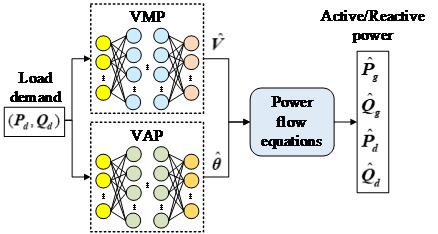

Opportunity
AC optimal power flow (AC-OPF) is a persistent problem in energy systems operation, but the increasing global reliance on renewable energy sources such as wind and solar has increased the uncertainties involved in AC-OPF calculation. This means that the problem needs to be solved more frequently and more rapidly in order to maintain stable and economic energy distribution. This invention employs deep neural networks that can predict voltage magnitudes and power generations. It also utilizes a post-processing methodology that can ensure the feasibility of the solutions that it produces. In comparison with other contemporary state-of-the-art approaches, this invention has greater speedup in computation and better performance in preserving the feasibility of its solutions.
Technology
This invention solves AC optimal power flow (AC-OPF) problems using a deep neural network. Independent variables in calculating OPF are predicted and then used to obtain dependent variables. The deep neural network DeepOPF-V receives input about load demands and then calculates voltage magnitudes and angles, and these calculations can then be directly used in calculating energy distribution. Deep neural networks rely heavily on improving the feasibility of their predicted solutions, so this invention employs a fast post-processing method that involves two steps. First, the active and reactive power generation constraints are checked. Second, if any constraints are violated, voltage magnitudes and angles are adjusted.
Advantages
- According to experimental results, this invention outperforms currently available commercial deep neural networks that find AC-OPF solutions in speed by three orders of magnitude. This means that it will be able to respond to rapidly changing energy supply conditions much better than other problem solvers.
- This invention outperforms other deep neural networks in ensuring solution feasibility.
Applications
- Power companies in China can use the invention to increase the efficiency of energy systems
- Power companies in the United States can use the invention to increase the efficiency of energy systems
- Power companies in the E.U. can use the invention to increase the efficiency of energy systems




